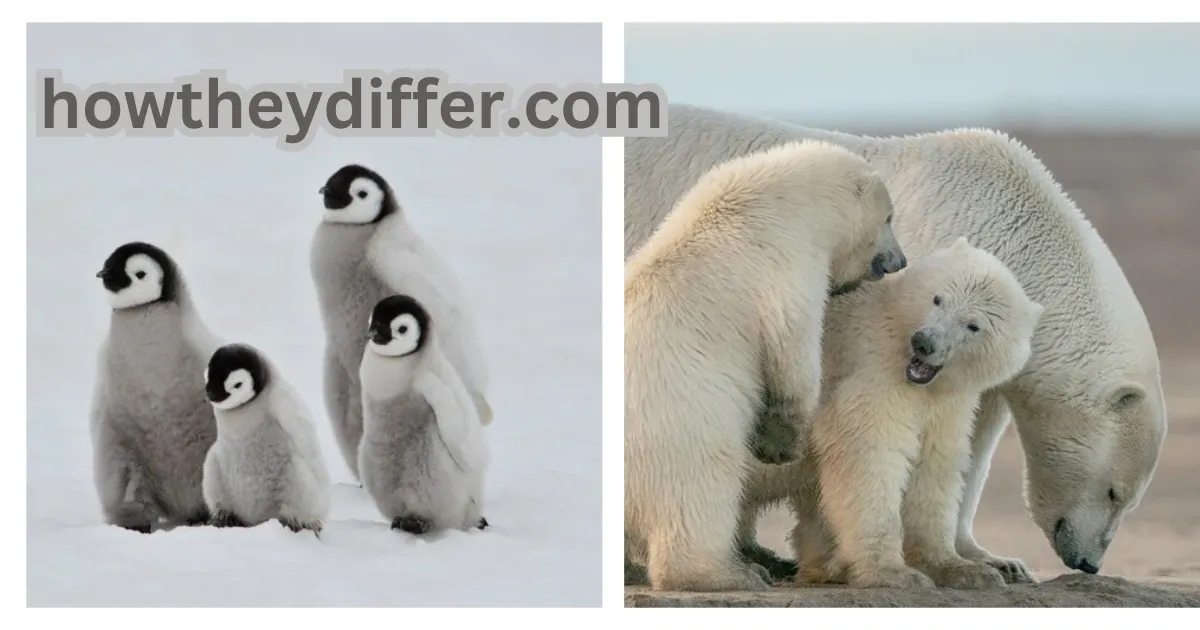Penguins waddle on the ice, polar bears roam on land. Both are iconic animals associated with icy landscapes, but that’s where the similarities end. It might seem obvious to some, but many people, especially young learners, often mix up these two amazing creatures.
Understanding the differences between penguins and polar bears isn’t just about knowing your animals; it’s about appreciating the incredible diversity of life on Earth and how animals adapt to their unique environments.
Why the Confusion?
So, why do people confuse penguins and polar bears? Here are a few reasons:
- Icy Habitats: Both animals are often shown in movies, books, and cartoons living in snowy, icy environments.
- Black and White Coloring: Both have distinct black and white coloring, which can make them seem similar at first glance.
- Popular Culture: Sometimes, cartoons and stories incorrectly depict penguins and polar bears living together, further adding to the confusion.
Do Polar Bears and Penguins Live Together
Despite often being associated with each other due to their icy habitats, polar bears and penguins do not live together.
Polar bears reign supreme in the Arctic region of the Northern Hemisphere, while penguins are found exclusively in the Southern Hemisphere, primarily in Antarctica.
This geographical separation ensures that these two species never encounter each other in the wild.
Penguins vs. Polar Bears
Let’s clear up the confusion once and for all! Here’s a breakdown of the key differences between penguins and polar bears:
Habitat and Location
This is the biggest difference! Penguins and polar bears live at opposite ends of the Earth.
- Penguins: Found almost exclusively in the Southern Hemisphere, with most species living in Antarctica.
- Polar Bears: Live in the Arctic regions of the Northern Hemisphere, including countries like Canada, Russia, Greenland, Norway, and the United States (Alaska).
Think of it this way: penguins live near the South Pole, while polar bears live near the North Pole. They would never meet in the wild!
Physical Characteristics
| Feature | Penguins | Polar Bears |
|---|---|---|
| Body Shape | Torpedo-shaped body, short legs | Large and powerful body, long legs |
| Wings/Flippers | Flippers for swimming | Paws with sharp claws for walking and hunting |
| Covering | Dense, waterproof feathers | Thick fur and a layer of blubber |
| Size | Generally small, ranging from 1 to 4 feet tall | Large, typically 7 to 10 feet long |
| Weight | Can weigh from 2 to 80 pounds | Can weigh from 600 to 1,700 pounds |
| Other | Webbed feet, strong beak | Excellent swimmers, strong sense of smell |
Diet and Hunting
- Penguins: Carnivores that feed primarily on krill, squid, and fish, which they catch while swimming in the ocean.
- Polar Bears: Also carnivores, but their main prey is seals. They hunt by waiting near breathing holes in the ice or by ambushing seals on land.
Social Behavior
- Penguins: Often live in large colonies, especially during breeding season. They have complex social interactions and communication.
- Polar Bears: Mostly solitary animals, except for mothers with cubs.
Adaptations to the Environment
Both penguins and polar bears have amazing adaptations to survive in their freezing environments:
- Penguins: Their dense feathers and a layer of blubber keep them warm in icy water. They also huddle together for warmth.
- Polar Bears: Their thick fur and blubber provide excellent insulation. They also have large paws with rough pads and non-retractable claws for walking on ice and snow.
Why Do Penguins and Polar Bears Never Meet?
Penguins and polar bears never meet in the wild due to their vastly different habitats. Penguins are flightless birds that live exclusively in the Southern Hemisphere, primarily in Antarctica and its surrounding islands.
Polar bears, on the other hand, are apex predators found only in the Arctic region of the Northern Hemisphere.
The geographical distance and contrasting environments between the two poles prevent these iconic animals from ever crossing paths.
Conclusion
While penguins and polar bears might share a black and white color scheme and a fondness for icy environments, they are vastly different creatures.
Penguins are flightless birds that thrive in the oceans of the Southern Hemisphere, while polar bears are powerful land predators that rule the Arctic North.
Understanding these differences helps us appreciate the incredible diversity of our planet and the amazing ways animals adapt to their surroundings.
FAQs
Some of the frequently inquired questions regarding the differences between penguins and polar bears are as follow:
Can penguins and polar bears live together?
No, penguins and polar bears live in completely different parts of the world and would never encounter each other in the wild.
What do penguins eat?
Penguins primarily eat krill, squid, and fish.
What do polar bears eat?
Polar bears mainly eat seals, but they may also eat other Arctic animals, such as walruses, birds, and fish.
Why do penguins waddle?
Penguins waddle because their legs are short and set far back on their bodies. This helps them swim efficiently but makes walking on land a bit awkward.
Why are polar bears white?
Polar bears have white fur to help them camouflage in their snowy and icy environment. This makes it easier for them to sneak up on their prey.
